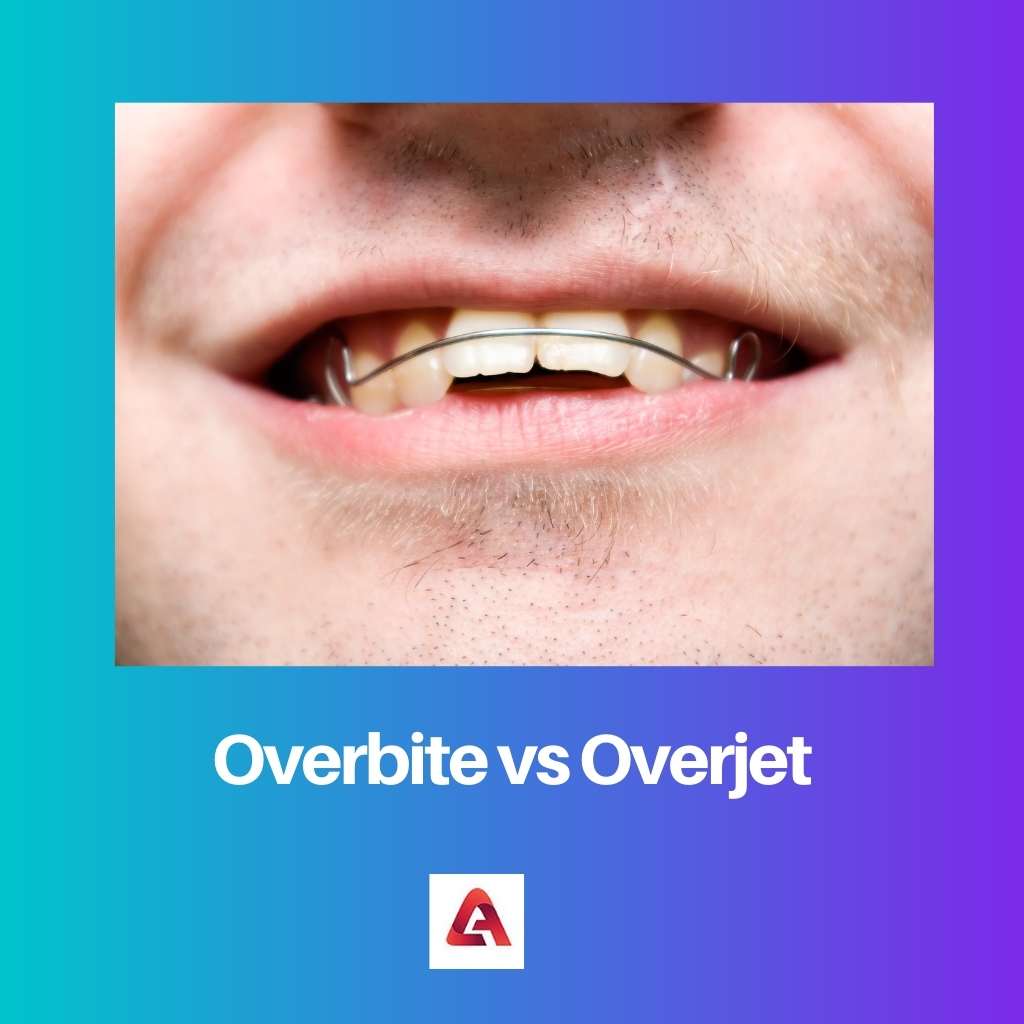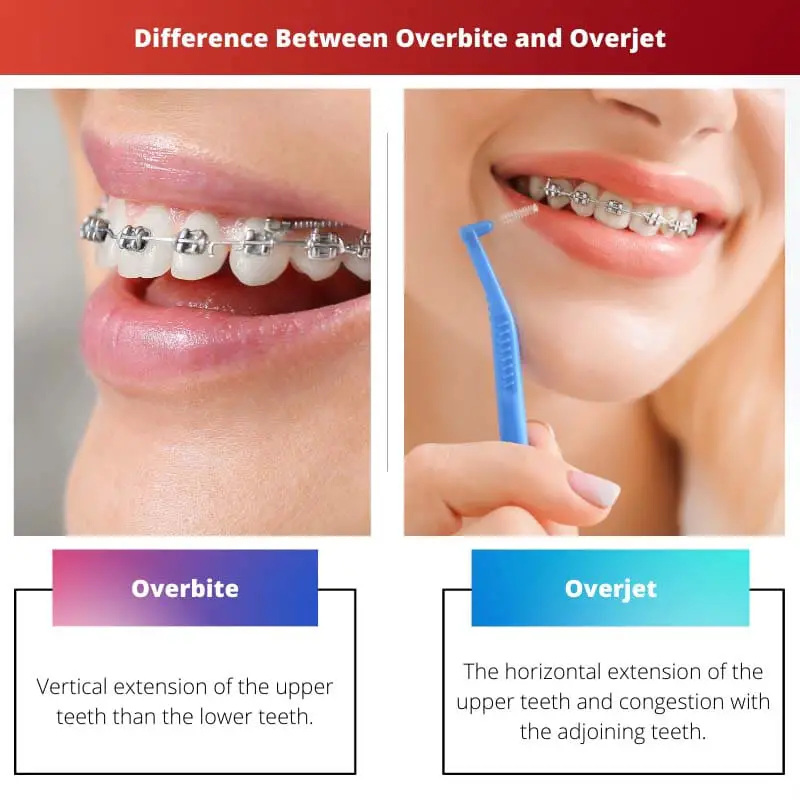Around 20% of the population is estimated to have malocclusion, which is the misalignment of our teeth.
It is common to say that malocclusion has one classification, but it has been proved scientifically that there are two types of malocclusion: overbite and overjet.
Generally, it is assumed that overbite and overjet are common, but they vary in many parameters.
Key Takeaways
- Overbite describes the vertical overlap of the upper front teeth over the lower front teeth; overjet measures the horizontal distance between the upper and lower front teeth.
- Overbites result from overgrown upper jawbones or underdeveloped lower jawbones; overjets occur when upper teeth protrude or lower teeth angle inward.
- Treatment for both conditions includes orthodontic appliances, dental braces, or surgery in severe cases.
Overbite vs Overjet
An overbite is a type of malocclusion where the upper teeth significantly overlap the lower teeth when the mouth is closed. An overjet, another type of malocclusion, occurs when the upper teeth protrude horizontally beyond the lower teeth, creating a gap visible from the side.

An overbite refers to the upper teeth extending straight down more than the lower teeth by more than 3mm. It is more like a vertical extension of the upper teeth, which causes lower teeth congestion and pain.
Although, the problem of overbite is common and can be cured easily when appropriate measures are taken at the childhood stage teeth.
Overjet refers to the upper teeth extending sideways and causing problems to the neighbouring teeth. It is more like a horizontal extension of the upper teeth and causes congestion and pain to the adjacent teeth.
Getting it cured in childhood or when the problems become noticeable is highly advisable.
Comparison Table
| Parameters of Comparison | Overbite | Overjet |
|---|---|---|
| Definition | Vertical extension of the upper teeth than the lower teeth. | The horizontal extension of the upper teeth and congestion with the adjoining teeth. |
| Treatment | Overjet is a little complicated to cure but is curable using Invisalign & bonding etc. | Hereditary issues are considered to be the leading cause of overjet. |
| Causes | Improper childhood habits like thumb sucking or using feeding bottles, etc. | They cause pain to the neighbouring teeth as it extends horizontally. |
| Problems | They cause pain in the lower teeth due to the congestion between the upper & lower teeth. | It results in difficulty chewing, damage of gums or causes trouble sleeping, etc. |
| Difficulty | It results in difficulty eating, gums infection, or fractured teeth. | It results in difficulty in eating, infection of gums, or fractured teeth. |
What is Overbite?
Overbite is the extension of upper teeth straight down which causes congestion to the lower part of the teeth and causes pain. It is known as the vertical extension of the teeth. Overbite is quite common among kids and is less complicated to cure.
The leading causes of overbite are due to improper childhood habits.
It is widespread for babies to suck their thumbs and drink milk from feeding bottles as they have no teeth, but it is not healthy for the teeth to continue the same habits after a certain age or the growth of a child’s teeth.
Excessive sucking of the thumb by the child pushes the upper teeth straight down, and prolonged bottle feedings do the same to the upper teeth. Hence, these are the common causes of an overbite, and highly advisable to prevent these habits during childhood.
Overbite can be cured easily when noticed initially and appropriate measures are taken. It is not a complicated problem and hence can be fixed by the traditional methods of wearing braces.
However, if the severity is a little higher, it can be cured by using veneers or crowns, etc., and treatment may differ according to the severity of the issue.
What is Overjet?
Overbite is the extension of upper teeth sideways which causes congestion to the neighbouring or adjoining teeth and causes pain. It is known as the horizontal extension of the teeth.
Overjet is a little complicated to cure, and highly advisable to get it cured early.
Hereditary problems cause Overjet. A genetic problem is known as some problem or disease which runs in our family generation over generation.
But hereditary alone isn’t the cause of overjet. Overjet can be caused by other issues like improper childhood habits mentioned before.
Overjet causes problems or difficulty in chewing and eating, damage or infection in gums and even leads to the fracturing of teeth. They also cause trouble while sleeping, or when it is severe, we may find problems in closing our mouths too.
The horizontal extension of the teeth shouldn’t extend over 3mm.
Overjet can be cured without complication when it is noticed early and appropriate measures are taken. It gets complicated when it is left untreated.
Overjet can be cured by using the traditional method of wearing braces. However, the treatment of the overjet can be complicated depending on the severity of the issue.
Main Differences Between Overbite and Overjet
- The difference between overbite and overjet is that overbite is the vertical extension of the upper teeth, while overjet is the horizontal extension of the upper teeth.
- Overbite can be cured easily, while curing overjet is a little complicated.
- Both overbite and overjet appear the same, but their differences lie in the angle of the extension of the upper teeth.
- Overbite is caused due to improper childhood habits, while overjet is caused due to hereditary problems.
- Overbite causes pain in the lower teeth, while overjet causes pain in adjoining teeth and results in damage of the teeth.




